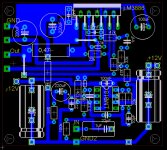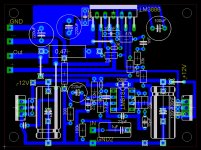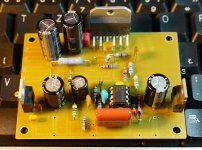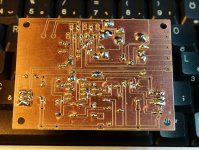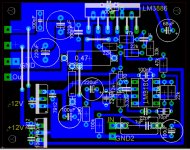Not only those resistors must be of the required value, but they must be of the highest possible precision, too: 0.1% or better (0.01% recommended).
I would follow UnixMan's advice...
While it will work, as LinuxGuru pointed out, I would stick to designer's values.
Also very important is the 0.1% spec, those resistors will keep the matching at different temperatures, 1% parts hand matched to 0.1% give no guarantee about it.
Beware: not only the values are critical. The "My_Ref" is extremely sensitive to components "quality" too. That is brand and model. You may get anything from excellent to horrible sound quality depending on which parts you use to build it!
A few months ago I built a My_Ref Rev C using no esoteric components except for a couple of silver mica capacitors that were not really necessary, and the amp sounds very good. I really don't think its possible for a well constructed My-Ref that uses appropriate components to sound "horrible". In this case selecting the "right" components simply makes a very good amp excellent.
IMHO, you're both right.
The My_Ref will sound very good with normal industrial parts but, nevertheless, a bad selection of industrial parts can make it sound not so good.
In the Fremen Edition of the My_Ref the BOM is made of industrial parts carefully selected to give best results and some 'boutique' parts are suggested to improve things further.
Apart very few exceptions all resistors sound OK but when compared to others a lot of differences can be heard...
Some sound soft with low bass content (like Vishay CMF, Tyco RC55Y), some hides a pretty good part of reverbs and tiny details (like Arcol), some are bass heavy (like Yageo and PRP).
Bulk metal foil resistors (which BTW are industrial parts but very high in price) give always best results.
For a plain My_Ref, which uses through hole parts I would recommend Vishay MBB0207 resistors.
They're sensibly priced, very balanced, very low noise and detailed.
They were recently introduced in Mouser's catalog and they're going to replace KOAs in the Fremen Edition BOM for through hole resistors.
The strange thing is that 1% version sounds better (more balanced) than 0.1% one...
Dario, unixman n linux guru: Thank u for your attention n highly appreciate for your advice. I will try to match some cheap resistor and replace installed the resistor (TKD 0.05%)
hello, i buy fake board from ebay, play around. everything different but same schematic, this i check.
i change resistors, even burn a chip, but now i can safe change them try how to tune sound.
question- change r9 (47k to ground) and sound become different until unstable. from 47-70k relay still click. but what purpose r9 in howland current pump? when 70k ohm, the sound more 'thick'? warmer, and less clear sound, but maybe more pleasant. what happen to the current pump when r9 increase? thank you.
i change resistors, even burn a chip, but now i can safe change them try how to tune sound.
question- change r9 (47k to ground) and sound become different until unstable. from 47-70k relay still click. but what purpose r9 in howland current pump? when 70k ohm, the sound more 'thick'? warmer, and less clear sound, but maybe more pleasant. what happen to the current pump when r9 increase? thank you.
R5, R8, R6 and R9 are part of the Improved Howland Current Pump (Voltage to Current converter), and they need to be pairwise-matched very accurately for the Current Pump to work accurately (otherwise, there's also a voltage component in the transfer function).
R5 has to be closely matched to R8, and R6 to R9. If you change any of these in such a way that they're no longer matched, the chipamp (Current Pump) no longer works as a pure current pump, and the sonics and stability will be impaired. As you noticed, it was not stable even at DC when R9 was increased above 70k.
(However, you can make small changes as long as both R6 and R9 are matched - I've used 49.9k, 51.1k and similar values without problems).
R5 has to be closely matched to R8, and R6 to R9. If you change any of these in such a way that they're no longer matched, the chipamp (Current Pump) no longer works as a pure current pump, and the sonics and stability will be impaired. As you noticed, it was not stable even at DC when R9 was increased above 70k.
(However, you can make small changes as long as both R6 and R9 are matched - I've used 49.9k, 51.1k and similar values without problems).
thank you linux.
what about ratio 47:22? can they change ratio maybe 22k, 22k? what happen then to current?
i even change ratio 100k, 22k. and sound become thin but strong. i would like know if this because there more current, or less current. 😀
what about ratio 47:22? can they change ratio maybe 22k, 22k? what happen then to current?
i even change ratio 100k, 22k. and sound become thin but strong. i would like know if this because there more current, or less current. 😀
If you change the 47:22 ratio to 22:22, the transconductance of the current-pump almost doubles and the loop will become less stable or probably unstable. You can recover stability by increasing R3 to ~1 ohm, but then the power dissipation in R3 doubles.
All in all, the original values are nearly optimal for both sonics and stability with the single LM3886 in the MyRef (though there may be some room for experimentation with dual current-pump topologies like the MyRef X2 or Mauro's Evolution).
All in all, the original values are nearly optimal for both sonics and stability with the single LM3886 in the MyRef (though there may be some room for experimentation with dual current-pump topologies like the MyRef X2 or Mauro's Evolution).
Last edited:
I remember was a pdf for etching your boards. My first prototype was based în this. There îs an GB ongoing for an upgraded Fremen version
Sent from my Nexus 5 using Tapatalk
Sent from my Nexus 5 using Tapatalk
I remember was a pdf for etching your boards. My first prototype was based în this. There îs an GB ongoing for an upgraded Fremen version
Sent from my Nexus 5 using Tapatalk
Thanks. I would like to mill it, for that a gerber is needed.🙁
Is a gerber file available for this project?
Thanks
For the original stereo PCB by Mauro Penasa:
ARCHIVIO SCHEMI E PROGETTI AUDIO
For the monoblock PCB by Russ-White:
http://www.diyaudio.com/forums/chip-amps/54571-my-audiophile-lm3886-approach-61.html#post1685875
Second version
Hello,
I made a second version of the amp. A small and dense board.
Tested it, the 1W THD is -84dB. With a 2x35V supply, it delivers 45W. This is still a single sided PCB with 4 jumpers.
The left side two jumpers have to be replaced with zener's if the supply voltage is above 35V, also if you are in to audiophile capacitors, you can replace C13 with a jumper and place the larger cap in the vicinity of the input connectors.
Hello,
I made a second version of the amp. A small and dense board.
Tested it, the 1W THD is -84dB. With a 2x35V supply, it delivers 45W. This is still a single sided PCB with 4 jumpers.
The left side two jumpers have to be replaced with zener's if the supply voltage is above 35V, also if you are in to audiophile capacitors, you can replace C13 with a jumper and place the larger cap in the vicinity of the input connectors.
Attachments
Reviving an old thread: I completed MyRef Rev C (Linuxguru's board + premium kit) after some struggle. I really like the sound, especially the bass weight with its slightly rounded texture and the wonderful midrange. Hearing the euphonic midrange, I berated myself for not having completed this build five years ago when I bought the kit from Linuxguru. However, the highs are rolled off compared to other amps I own/heard. I would love a little more liveliness in the treble to better match the superb mids and bass.
Can builders suggest mods/tweaks or change of component value that could improve the highs? Thanks in advance.
Input coupling is a no-name 2.2 uF polystyrene. I know this cap is critical but I haven't been able to get a better one yet. I may try a Russian PIO cap in future as it works very well on some other builds.
Or alternately I could kick out this cap altogether and DC couple it, since I feel the buffer feeding the MyRef has very low DC offset (a couple of mV). And MyRef itself has very low offset on both channels (~4 mV or lesser).
Can builders suggest mods/tweaks or change of component value that could improve the highs? Thanks in advance.
Input coupling is a no-name 2.2 uF polystyrene. I know this cap is critical but I haven't been able to get a better one yet. I may try a Russian PIO cap in future as it works very well on some other builds.
Or alternately I could kick out this cap altogether and DC couple it, since I feel the buffer feeding the MyRef has very low DC offset (a couple of mV). And MyRef itself has very low offset on both channels (~4 mV or lesser).
- Home
- Amplifiers
- Chip Amps
- My "audiophile" LM3886 approach
